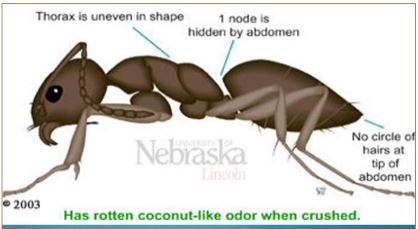Natter’s Notes
Jean R. Natter, OSU Master Gardener
Ants! They’re players in perhaps one of the oldest good-news-bad-news stories ever.
The good news is that ants are valued for their beneficial activities. They add large quantities of spent plant and animal remains into the soil as they cultivate and aerate the soil. They also create channels for water and roots. They’re predators, too, and are members of nature’s clean-up crew, carting away debris that includes stray crumbs and dead insects.
The bad news is that ants sometimes get carried away. If they aerate the soil in and around a rootball excessively, water passes through the soil too rapidly to soak in, the plant wilts, and may die. Then, too, people take a dismal view of their uninvited excursions indoors when they trail across the floor, headed for wayward crumbs or the pet’s dish.
The preferred method to “get rid” of ants is to use a commercially formulated ant bait. The ants feed on the bait, then carry some back to the nest to share with the family.
It’s critical to understand the meaning of “I want to get rid of ants; permanently” And they want it now! For the pest control professional, it’s we’ll stop them now, then we’ll return when they do.”
Here’s where Master Gardeners have a stellar opportunity to share a “teachable moment” during which they help a client, neighbor, or friend, understand the true outcome of managing house-invading ants. To be blunt, one can only stop the influx temporarily, until the next time.
Too often, people will only spray the visible ants in hopes of stopping the invaders. Unfortunately, applying that spray wastes time, money, and effort. It only affects the visible ants, a mere 10 percent, or less, of the nest’s population.
Whenever people report they have “sugar ants,” it’s likely they have odorous house ants, Tapinoma sessile. They’re just an 1/8-inch, and dark brown to shiny black. A quick and-dirty method to quickly verify their ID is to squash one or two. Then, they emit a distinctive, unpleasant odor which has been variously described as rotten coconut or petroleum-like.

Effective baits for odorous house ants include Terro (a borate-based liquid) and Combat (a gel with fipronil). I keep a 2-oz bottle of Terro on hand because odorous house ants are very persistent little fellows; they will return, repeatedly through the year. Common events that tend to trigger an invasion at my place include after heavy rains; following a serious cold spell; and during summer’s heat. Sometimes, I wonder if they’re just in the mood.
After bait is set out, monitor activity. Add fresh bait as long as the ants stream in. It may take weeks until the foragers stop feeding. If they’re still going strong after 3 weeks, try another bait, this time with a different active ingredient, perhaps hydramethylnon or indoxacarb.
Frankly, everyone must discard their fantasies about eradicating ants. The more accurate strategy, although it may be far less satisfying, is to make a plan to limit the indoor invaders.
Odorous house ants, Tapinoma sessile, are probably the most common house-invading ants across the country. They’re small, dark brown or black ants, 1/16- to 1/8-inch long, with the usual 3 body parts of an insect – head, thorax, and abdomen. The characters which define them as ants are a petiole (a narrow connection between the thorax and abdomen) and two elbowed antennae. The characteristic which differentiates them from other ants is that their single petiolar node is very small and hidden by the abdomen. Then, too, when they’re crushed, they smell bad. Some people say the rather penetrating odor is similar to petroleum or rotted coconut.

Fig 2. Odorous house ant, Tapinoma sessile; lateral view. A key identification character is the small petiolar node hidden by the anterior portion of the abdomen. (https://lancaster.unl.edu/pest/ants/odorousant.shtml)
An odorous ant colony is relatively small, to about 10,000 individuals, with multiple queens. Nests are usually outdoors just below the soil surface, underneath pavers, wood piles, or other debris. But nests may also be indoors, in a wall void or near warmth-emitting sources.
Odorous house ant populations enlarge by one of two methods: mating of winged reproductives or via budding of the colony. Budding occurs when a hundred or so workers transport several of the colony’s queens to a new site. With time, a series of closely related, cooperative colonies forms — a supercolony. No wonder we can’t eradicate ants!
Managing ants requires a multi-pronged approach.
1. Sanitation (clean up regularly), and store perishable foodstuffs in tight, rigid containers.
2. Caulk and seal cracks in the foundation or gaps where utilities enter structures.
3. Manage honeydew-producing insects on landscape plants: mealybugs, whiteflies, as well as both soft and cottony scales.
4. Use commercially-formulated ant baits, refreshing the bait as needed until the foragers stop coming, perhaps as long as 3 weeks.
5. Keep a supply of effective bait on hand to use the next time the ants return!
Ant baits act slowly because the foragers share with other ants within the colony. If a bait is ineffective after several weeks, switch to one with a different active ingredient.
Commercial baits are formulated such that the foragers will survive long enough after feeding that they have sufficient time to carry bait home to colony members. (Editor’s note: Recall that Master Gardeners do not suggest home remedies.) When it comes to odorous house ants, have bait at hand so that you can rapidly respond to their subsequent invasions.
Resources
– Identification and habits of Key Ant Pests in the Pacific Northwest (http://cru.cahe.wsu.edu/CEPublications/PNW624/PNW624.pdf)
– “5 Most Common Ants in the Home”- https://extension.unl.edu/statewide/douglas-sarpy/pdfs/ce/resources/ce-five-most-common-ants-in-the-home.pdf– Ants: http://ipm.ucanr.edu/PMG/PESTNOTES/pn7411.html
– Odorous House Ant Identification Resources – https://lancaster.unl.edu/pest/ants/odorousant.shtml
– “Don’t Let Ants Come Over Uninvited: Pavement Ants and Odorous House Ants” – https://lancaster.unl.edu/pest/resources/356PavementandOdorousAnts.pdf Both ants are similar, about 1/8-inch long and a brown-black color. The main difference is that odorous ants have one petiolar node whereas pavement ants have 2. (See Figure 2, above.)
